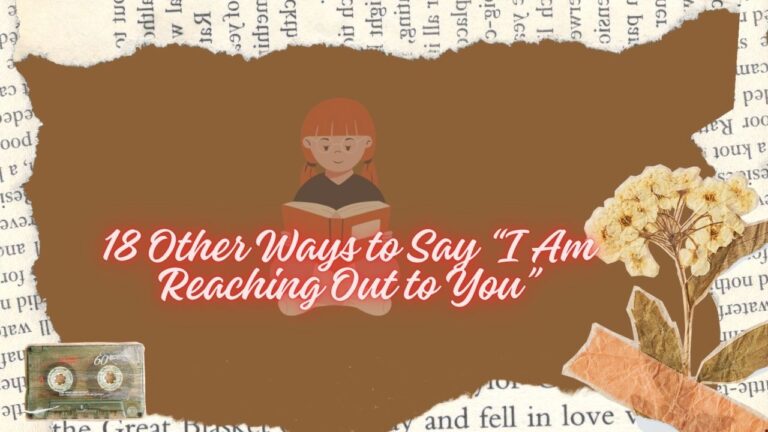When communicating professionally, it’s good to have alternatives for “I am reaching out to you.” Instead of using the same phrase, you can say “I am contacting you,” “I am getting in touch,” or “I wanted to connect.”
Other options include “I am following up,” “I am writing to you,” or “I wanted to reach out.” These alternatives help make your messages more engaging and less repetitive. Choosing the right phrase depends on the tone and context of your conversation.
What Did “I Am Reaching Out to You” Mean?
“I am reaching out to you” means you are trying to contact or connect with someone for a specific reason. It is often used in professional or formal communication to start a conversation, ask for help, share information, or follow up on something. This phrase makes the message sound more polite and engaging rather than direct or demanding.
Advantages and Disadvantages
Advantages of Saying “I Am Reaching Out to You”
- Polite and professional – It sounds respectful and friendly in business communication.
- Engaging tone – Makes the message feel less direct or demanding.
- Versatile usage – Suitable for emails, calls, and networking.
- Encourages conversation – Invites the recipient to respond positively.
Disadvantages of Saying “I Am Reaching Out to You”
- Overused phrase – Can sound generic or repetitive in professional settings.
- Not always clear – May not directly state the purpose of the message.
- Too formal for casual talks – Might not suit informal conversations.
- Longer than necessary – Simpler alternatives like “I’m contacting you” may be more direct.
Synonyms
- I am contacting you
- I am getting in touch
- I wanted to connect with you
- I am following up
- I am writing to you
- I wanted to reach out
- I’d like to touch base
- I am checking in
- I hope to connect with you
- I wanted to follow up
- I am reaching out regarding…
- I am dropping you a line
- I wanted to ask about…
- I’d love to hear from you
- I am sending this message to…
- I’d like to discuss…
- I’m making contact
- Just a quick note to…
I am contacting you
This phrase is a direct and professional way to start a conversation. It is often used in formal emails or business messages. It clearly states that you are reaching out with a purpose.
Example:
“I am contacting you regarding the job opening at your company and would love to discuss my qualifications.”
Short Letter:
Dear [Name],
I am contacting you to inquire about the recent job listing at [Company Name]. I am highly interested in this opportunity and would love to discuss how my skills align with your needs. Please let me know a convenient time to talk.
Best regards,
[Your Name]
I am getting in touch
This phrase is casual yet professional, often used when reaching out after a long time. It makes the message sound more friendly and natural.
Example:
“I am getting in touch to see if you are available for a quick meeting next week.”
Short Letter:
Hi [Name],
I am getting in touch to see if we can schedule a quick catch-up call. I’d love to discuss some exciting updates. Let me know when you’re available!
Best,
[Your Name]
I wanted to connect with you
This phrase is warm and engaging, often used for networking and professional conversations. It implies a desire to build a connection.
Example:
“I wanted to connect with you to learn more about your experience in the tech industry.”
Short Letter:
Hello [Name],
I wanted to connect with you because I admire your work in [Field]. I’d love to learn more about your experiences and discuss potential collaboration opportunities. Looking forward to your response!
Best,
[Your Name]
I am following up
This phrase is ideal for reminders or when you need a response to a previous message. It shows persistence while remaining polite.
Example:
“I am following up on my previous email regarding our upcoming project discussion.”
Short Letter:
Dear [Name],
I am following up on my email from last week regarding the proposal. I wanted to check if you had any updates or feedback. Looking forward to hearing from you soon.
Best,
[Your Name]
I am writing to you
This phrase is formal and clear, often used in professional emails, letters, and applications. It is suitable for official communication.
Example:
“I am writing to you to express my interest in the marketing position at your company.”
Short Letter:
Dear [Name],
I am writing to you to request information about your training programs. I am interested in enhancing my skills and would appreciate any details you can provide. Thank you for your time.
Sincerely,
[Your Name]
I wanted to reach out
This phrase is friendly and professional, often used when initiating a conversation or asking for information.
Example:
“I wanted to reach out to see if you’d be interested in collaborating on a new project.”
Short Letter:
Hi [Name],
I wanted to reach out to discuss a potential partnership opportunity. I believe our skills align well and could lead to something great. Let me know if you’d like to chat!
Best,
[Your Name]
I’d like to touch base
This phrase is informal yet professional, commonly used in business settings to suggest a brief conversation or update.
Example:
“I’d like to touch base to review our progress on the project before the deadline.”
Short Letter:
Hello [Name],
I’d like to touch base regarding our upcoming meeting. Let me know if you have any updates or if we need to adjust our plans. Looking forward to catching up!
Best,
[Your Name]
I am checking in
This phrase is casual and polite, often used when asking for an update or following up on a conversation.
Example:
“I am checking in to see if you need any assistance with the project.”
Short Letter:
Hi [Name],
I am checking in to see if you need any further details regarding the report. Let me know if there’s anything I can help with.
Best,
[Your Name]
I hope to connect with you
This phrase expresses interest in communication while keeping the tone polite and engaging.
Example:
“I hope to connect with you soon to discuss potential collaboration opportunities.”
Short Letter:
Dear [Name],
I hope to connect with you soon to discuss how we can work together. I admire your work and believe we have shared interests. Looking forward to your response!
Best,
[Your Name]
I wanted to follow up
This phrase is a polite way to remind someone about a previous conversation, email, or request.
Example:
“I wanted to follow up on my job application and see if there are any updates.”
Short Letter:
Dear [Name],
I wanted to follow up on my application for the marketing role. I am very interested in the position and would love to hear any updates. Looking forward to your response!
Best,
[Your Name]
I am reaching out regarding…
This phrase is direct and professional, helping to clarify the purpose of your message immediately.
Example:
“I am reaching out regarding the partnership opportunity we discussed last week.”
Short Letter:
Dear [Name],
I am reaching out regarding the open position at your company. I would love to apply and discuss my qualifications. Please let me know the next steps.
Best,
[Your Name]
I am dropping you a line
This phrase is informal and friendly, often used for casual check-ins or short messages.
Example:
“I am dropping you a line to see how you’ve been and catch up.”
Short Letter:
Hey [Name],
I am dropping you a line to see how you’re doing. It’s been a while since we last talked, and I’d love to catch up! Let me know when you’re free.
Best,
[Your Name]
I wanted to ask about…
This phrase is polite and direct, making it clear that you have a specific question.
Example:
“I wanted to ask about the details of your upcoming event.”
Short Letter:
Hi [Name],
I wanted to ask about the registration process for your workshop. Could you provide more details? Looking forward to your response!
Best,
[Your Name]
I’d love to hear from you
This phrase is warm and engaging, encouraging a response.
Example:
“I’d love to hear from you and discuss potential opportunities for collaboration.”
Short Letter:
Dear [Name],
I’d love to hear from you regarding the project proposal. Let me know your thoughts when you get a chance!
Best,
[Your Name]
I am sending this message to…
This phrase makes it clear that your message has a specific purpose.
Example:
“I am sending this message to confirm our meeting time.”
Short Letter:
Hi [Name],
I am sending this message to confirm our appointment for Tuesday at 3 PM. Please let me know if this time still works for you.
Best,
[Your Name]
I’d like to discuss…
This phrase is direct and professional, useful when you want to bring up a topic.
Example:
“I’d like to discuss our next steps for the project.”
Short Letter:
Dear [Name],
I’d like to discuss the new strategy for our marketing campaign. Let’s set up a meeting to go over the details. Let me know when you’re available!
Best,
[Your Name]
I’m making contact
This phrase is simple and clear, good for formal introductions.
Example:
“I’m making contact to introduce myself and discuss a business opportunity.”
Short Letter:
Dear [Name],
I’m making contact to introduce myself and explore ways we can work together. I look forward to your response!
Best,
[Your Name]
Just a quick note to…
This phrase is casual and friendly, great for short messages.
Example:
“Just a quick note to say thank you for your support.”
Short Letter:
Hi [Name],
Just a quick note to say I appreciate your help with the project. Looking forward to working together again!
Best,
[Your Name]
Conclusion
Using different ways to say “I am reaching out to you” helps make your communication more engaging, professional, and clear. Whether you’re following up, introducing yourself, or making a request, choosing the right phrase sets the right tone.
A formal phrase like “I am writing to you” works well in business emails, while “Just a quick note to” is great for casual messages. By varying your language, you can avoid repetition and improve your professional communication.

SEO specialist focused on enhancing website visibility, driving organic traffic, and optimizing user experience for better conversions.







